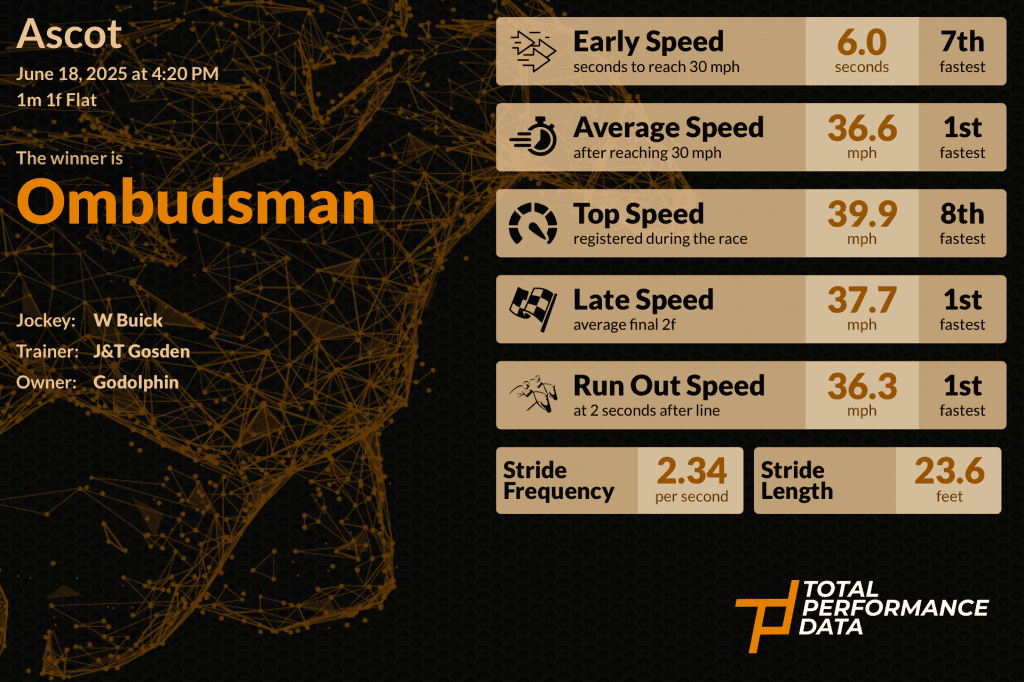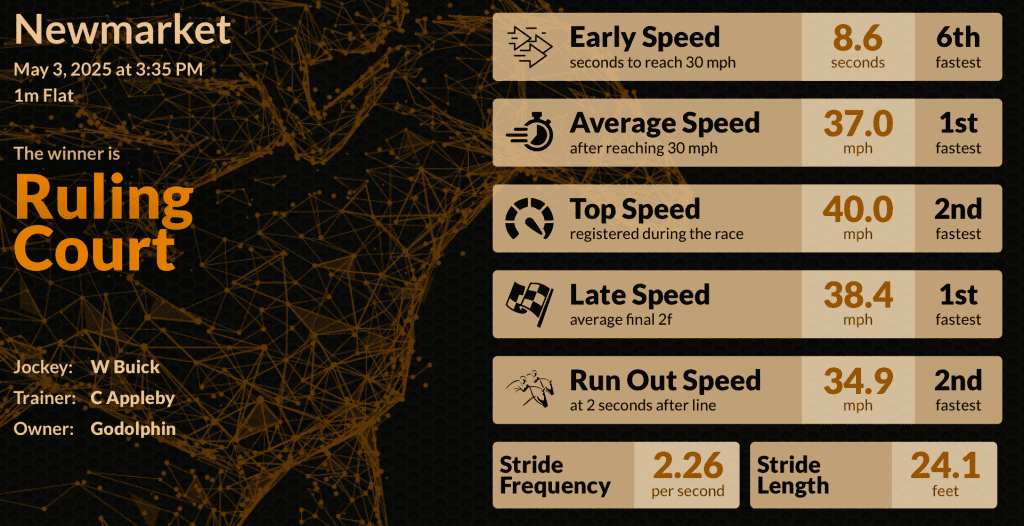

Ombudsman is the obvious place to start. The suggestion from certain racing services that his victory in the Prince of Wales’s Stakes at Royal Ascot made him one of the highest rated racehorses in the world is probably a bit of an overreaction, but this was still a clear best for his short career. A winning time of 2:02.51 was 2.27s faster than the TPD expected time for the conditions at Ascot and the fastest winning time in that race since The Fugue in 2014. On a purely times based assessment, this was an enormous performance and a clear best from the Gosden’s charge and given that it was just his 6th career start, there is every reason to believe that there is further improvement to come. However, the other side of that argument is that with a top speed of 39.86 mph, Ombudsman was ranked 8th of 8 and an average stride length of 23.59 ft saw him ranked 7th. He was short of room and forced to switch in the closing stages and once in the clear, he did quicken to run the fastest final furlong in 11.82s. He’s a worthy favourite for this race and the presence of a couple of Ballydoyle runners and Ruling Court in the Godolphin blue should help to ensure that this race is truly run to suit him. He has weight to concede and at this time of the year that’s an important factor. I’m not overly surprised to see that William Buick chose to ride him over Ruling Court, but all 6 of his rivals were slowing down in the final furlong at Ascot and that seems less likely at Sandown this weekend.
Hotazhell seems unlikely to trouble the judge at this level. He won the Futurity Stakes at Doncaster on deep ground in the autumn and after missing his intended return in the French 2,000 Guineas when he was a late non-runner, he ran well without looking like winning in the Irish equivalent at the Curragh. That did come behind Field of Gold and if we take that form literally, then he should at least be competitive with Ruling Court. However, whilst he made some late headway, he was still slower than the front 2 in the final furlong, closing in 12.05s (ranked 5th) and his top speed of 40.65 mph was significantly slower than the winner at 41.85 mph. He is a group 1 performer and showed more than enough at the Curragh to suggest that he has trained on, but even with his weight for age allowance, the ground seems unlikely to be soft enough for him to cause an upset and the likelihood is that he will be left behind at the 2-furlong pole.
Ryan Moore choosing to ride Delacroix over Camille Pissarro has been one of the key story lines in the build up to this year’s race. Sometimes he gets it right and on other occasions, most notably the Derby, he gets it wrong. There’s a clearly lot of faith behind this horse and he is perhaps best forgiven his run at Epsom where he was too far back and never able to get involved. He beat Lambourn in the Ballysax in March, though the runner-up did run the fastest final furlong, but that form, along with his Derby trial win at Leopardstown in May would suggest that there is a group 1 performer in there. However, he’s on a retrieval mission and having ranked 10th and 9th respectively for his final furlong and run-out speed at Epsom, there is a considerable leap of faith required from Ryan Moore at this level. Camille Pissarro has much stronger claims. The form of his victory in the Prix du Jockey Club is open to question and he was favoured by the way the race panned out from the draw, but he ran a final furlong of 11.65s, faster than the 3 horses to chase him home and the form of his stablemate, Trinity College, has done plenty to boost that form since. My issue with the form is linked to the nature of the track at Chantilly. A right-handed teardrop shape forces plenty of the horses drawn high to drop in and as a result the front runners can dominate. The gaps came and Ryan Moore had the experience to ride for them, but both the 5th and 6th placed horses were faster than the winner over the final 600-metres and in a 6-runner field at Sandown, there won’t be a track bias to aid his cause this time around. He’s achieved more than Delacroix at this stage of the season, but there’s no pacemaker for him to track and his top speed of 62.5 km/h at Chantilly would suggest that he will need to find some more speed against better horses here.


It’s hard to know what to make of Ruling Court. Clearly being trained for the Derby, only to then be a late withdrawal and then re-route to the St James’ Palace Stakes over a shorter trip wasn’t ideal. He didn’t travel particularly well at Ascot, though he is unlikely to have beaten Field of Gold in any case. On the pick of his form, most notably the 2,000 Guineas and his win in Dubai, he would have a chance, but at no point in the race at Ascot did he run the fastest individual furlong split and he was over a second slower than the winner overall. I think that there’s a good chance that he could lead here, but as he steps up in trip for the first time, it is anyone’s guess as to whether he has the ability to stay there at this point.
Finally we come to Sosie. It’s the age old dilemma of trying to compare French form with the UK and Ireland. Vadeni won this race a few years ago, but he was a 3-year-old getting all the allowances and the pair are very different types. Here’s what we can say. Sosie has won 3 Group 1 races already, including when dropping back to distances around this 10-furlong trip. He’s beaten Map of Stars in the Prix Ganay and Sardinian Warrior in the Prix D’Ispahan, running the fastest final furlong on both occasions and a penetrometer reading of 3,4 at Paris Longchamp in May would suggest that he will handle the ground at Sandown without any issue. He’s had the highest top speed figure on both occasions too and whilst he is favourite for the Arc de Triomphe, he has proven himself equally effective at this trip. He has recorded penultimate furlongs of 10.79 and 11.06s in his 2 starts at Paris Longchamp this year, having raced behind the leaders on both occasions. Whilst he handles soft ground and 12-furlongs very well, the assumption that he is a typical soft ground staying type from France is wrong. As a 3-year-old, he was beaten less than 3-lengths in the Prix du Jockey Club and less than 4-lengths in the Prix de L’Arc de Triomphe and an argument could be made that he has achieved at least a similar level of form to Ombudsman, if not slightly better.
The data would suggest that this race lacks an obvious pace angle, with a tentative suggestion that Ruling Court or Delacroix might go forwards. However this race plays out, it seems unlikely to follow a similar pattern to the frantic early pace that Ombudsman chased home in the Prince of Wales’s Stakes and whilst that bare form makes him a worthy favourite, he isn’t guaranteed to get the same setup. This feels like a no bet race to me. We can’t be sure which horse will lead, let alone how strong or sedate the early pace may be, but the data would suggest that Sosie is perhaps a little better than first thought under these conditions and were he to drift to around 5/1 or bigger, he would represent some value in an open race.